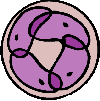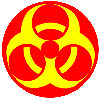
The material tech of the Titan effects:
- how fast the Titan can move (see engines)
- how large the Titan can be made during spawning. The total of all systems on the Titan must not exceed the material tech * 1.5.
- It can determine the maximum damage caused by critical
hits.
For example, tech 10 limits it to size 15, tech 11 to size 16 etc.

A titan dies if all of its computers are destroyed. Always try to build excess
computer capacity into your forces. Computers generate 'control points' equal
to the number of computers * computer tech, and it costs 1/5th of the system tech
to bootup weapons, shields or engines.
As the computer tech increases
in generation the scan range for the Titan grows. The generation boundaries occur
after 4, then 6, then 10 etc. (details elsewhere).
For example a Titan with computer tech of 21 counts as 2nd generation computer
tech which gives scan range of 5(basic)+2=7.
They can also be used for damage control but this is very expensive,
and uses 2*system tech control points for each system fixed. Click the
damaged components to assign repair orders; no repairs will occur
automatically.
For example,
3 units of computer at tech level 15 will produce (3*15)=45 control points.
To control 4 engines of tech level 12 will cost (4*12)/5=9.6
To damage control 1 engine of tech 12 costs (12*2) = 24

A Titan requires at least one engine.
Engines require control points
equal to the number of engines booted up * engine tech level*1/5th.
They produce
power equivalent to the number of engines booted up * engine tech level .
For example, 4 engines of engine tech 12 will use up 4*12*1/5 = 48/5=9.6
control points. They will produce power of 4*12=48.
The power can then
be allocated to shields and weapons or it can be used for movement. Movement cost
is determined by the total size of the Titan and the material tech used to build
it. Or to put it another way, the number of movement points available is :
available energy/(total Titan size*material tech) *(12-(engine tech/material
tech))
For example, a titan has 4 engines of tech level 12, and so produces
48 energy, the titan consists of 3 computer, 4 engine, 0 spawn, 1 shield and 2
weapons, giving a total size of 10. The titan is constructed with material technology
of 12, and engine tech of 12, so:
move pts = (48/(10*12))*(12-(12/12))
= (48/120)*11 = 4
The titan can thus move 4 lowland hexes, 2 highland
hexes or 1 mountain + 1 lowland.
Note 1:that all movement of Clan Halls costs twice as much, or you could say that a Clan Hall in flight mode moves only 1/2 the distance of a normal titan. This is to stop them running away easily!
Note 2:that the (12-(eng tech/material tech)) is called the Argyle Anchor, after the clan that discovered the inate imbalance from having high technology engines running on a low technology infrastructure.

The spawning chamber is where harvested bio-mass is kept until you want to
order the Titan to spawn another. It requires no energy or computer control.
A Titan can harvest a single unit of bio-mass per turn, the colour of bio-mass
effects how many spawning chambers are filled - number of chambers also effects
this. When spawning each full spawning chamber can be converted into 3 system
units in the child. For example 4 full spawning chambers could produce a child
with 12 system units in it (e.g. 4 comp, 4 engines, 2 shield, 2 weapons).
A titan can only harvest one type of bio-mass, this is determined by their tech generation (the sum of all their techs):
- Tech 0-14=
green bio-mass
Tech 15= orange bio-mass
Tech 50= Purple bio-mass
Tech 150= Blue bio-mass
As a titans tech generations increase it will move up to the higher bio-mass types. It can only harvest bio-mass of its own colour.
| Green bio-mass fills 1 spawning chamber. |
| Orange bio-mass fills 1 spawning chambers |
| Purple bio-mass fills 2 spawning chambers, providing the breeder has 6 or more spawning chambers, and it is not the first unit being filled. If it has less than 6, or this is the first unit being filled it will only be able to harvest 1 per turn. |
| Blue bio-mass will fill 3 spawning chambers, providing the breeder has 9 or more spawning chambers and it is not the first unit being filled. If it only has 6,7 or 8 then it can fill 2 per turn (unless first unit), and less than this only 1 per turn. |
A Titan does not have to have any spawning chambers, but if it wants some it must have at least 2. A Titan can never have a single spawning chamber.
Note: The strange rules about purple and blue fill rates are to ensure that it always takes at least 2 turns for breeders to spawn another titan, which preserves the advantage given by clan halls.
Damage control?
The Titans material tech is used when repairing spawning chambers. See the section on computers above for more detail on damage control.
Damage causing harvest loss - VENTING!
Every spawning chamber hit on a breeder may cause up to 3 spawning chambers to vent the harvested bio-mass. For example, a huge breeder with 20 spawning chambers has 17 full of bio-mass, 5 shots land, 3 of them on spawning chambers. This means the titan will void up to 9 units of harvested bio-mass, reducing the titan to 17 undamages spawning chambers, 8 of which are full.
Fighters and hybrids are imune to venting. Breeders are defined as have at least twice as many spawning chambers as weapons.

Shields are absolutely necessary. A shield rating of 100 or more means that any incoming shots will have a chance of being stopped. With a rating of 100 then the tech of the weapons firing v's the tech of shield determines the chance of a hit. Each hit then inflicts damage which is again worked out by comparing the weapons tech firing and the shield tech defending.
Shields require computer
control points equal to the number of shields booted up * shield tech level*1/5th.
Shields use up energy at the same rate as their tech level. E.g. a tech level
10 shield unit costs the same in energy as that produced by one unit of tech 10
engines.
Shield Rating
A shield rating of 150 is no better
than a rating of 100. One unit of shields of tech 10 protects up to 11 systems
on the Titan. If any system units are left unprotected (i.e. a shield rating of
less than 100) then an incoming hit will always get through the shields. Damaged
units do not need any shield protection, which means the shield rating will increase
as units get damaged (providing they are not shields of course!)
Another
interesting point (thanks Rob!) is that a salvo may destroy engines (say) and
so reduce the size of the Titan, which means succeeding salvoes will have to deal
with an increased shield rating!
As said above one unit of shield can
protect 11 systems on the Titan, this increases as shield tech increases generation,
this increase occurs after 4 tech levels, then 6 tech level, then 10 etc. So a
Titan with tech 20 (base 10 +4 +6) shields will be able to protect 13 other systems
for each unit of shield (basic 11 + 2).
Or to summarise
1 unit
of shield of tech 10 can protect 11 system units.
1 unit of shield of tech
14 can protect 12 system units.
1 unit of shield of tech 20 can protect 13
system units.
1 unit of shield of tech 30 can protect 14 system units.
The shield rating is worked out by:
(Total protected units)/(Current
size after damage) *100
Chance To Hit
Providing a titan has 100% shield coverage the chance to hit is worked out via the attackers weapon tech v's the defenders shield tech minus the firers experience effects.
If the attackers weap is 1/2 the defenders shield then there
will be a 15% chance of a hit.
If attackers weap is double the defenders shield
then there will be a 60% chance of a hit. The three tables below illustrate the
point.
|
|
|
|
The equation for this is weaptech/shieldtech*30.
What is the effect. Lets currently take a titan called 'Lil Man' with material, weap and shield of 30 and fight against a titan called 'old man' with material, weap and shield of 60.
Using the rules:
Lil
Man attacking Old man has a hit chance of 15%. Each hit of salvo damages 0.5 units.
Old Man attacking Lil Man has a hit chance of 60%. Each hit of the salvo damages
2 units.
So old man hits 4 times more than lil man, which is significant. But if Lil Man attacks with 8 titans then the odds are evened out, i.e. he should inflict twice as many hits, which each do half as much damage, making the amount of damage the same.
Another factor effecting the chance of a hit is the
experience of the attacking Titan, for each point of experience the chance of
a hit is increased. This is again on a sliding scale as describe by experience
effects.
Damage Per Hit
Shield tech also effects the amount of damage that an incoming shot which gets through shields inflicts. The damage inflicted per hit of a salvo is weap tech/shield tech. The table below shows some examples.
|
The number of hits can never be reduced below 1, or below number of hits that land/2, unless scored due to experience only. Also automatic hits are never reduced. See below. |
Note that the total number of hits is the dam per hit*number of hits. For example a salvo of 6 may inflict 4 hits, each inflicting 0.33 damage. So total damage is 4*0.33=1.33, which means 1 hit and a 33% chance of a further hit.
There are four types of hit that can be inflicted:
Automatic hit: These land on unshielded titans, or unshielded parts of titans. These hits may increase due to weapon tech, but they will never reduce to less than 1 unit destroyed per hit - ie shield tech never reduced automatic hits.
Primary hit: The shot penetrates the shield even without the firers experience. These shots will always do at least one damage, or 1/2 of all primary hits that land.
Secondary hit: The shot only hit due to experience. These shots do not benefit from the minimum damage rule, and advanced shielding can reduce the damage down to nothing.
Critical hits: These are detailed elsewhere.
Don't worry about auto,primary and secondary damage, its all invisible to the player and is handled by the game server. I only include the information above to keep you enlightened.

Weapons are what lets you kill! They require energy and control points equal to their weapons tech. The tech level of weapons also effects how far the Titan can fire and the effectiveness against shields has already been detailed.
Weapons
require computer control points equal to the number of weapons booted up * weap
tech level*1/5th.
Weapons use up energy at the same rate as their tech level.
E.g. a tech level 10 weapon unit costs the same in energy as that produced by
one unit of tech 10 engines.
The range that the weapon can fire is determined by the tech generation level as given in the table below
| Weapons tech | Fire range |
| 10 |
2 |
| 14 |
3 |
| 20 |
4 |
| 30 |
5 |
Weapons v's shield effects the chance of a hit and the damage inflicted per hit. All of the detail for this is given above for shields.
Weapons tech does not effect the chance of critical hits. When firing upon an enemy the chance of scoring a critical hit is 2% or 10% if a weapon is destroyed, each salvo can inflict a single critical hit which results in from 2 units to 1/4 of remaining systems of damage.